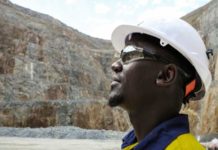
[miningmx.com] – THE lack of urgency in dealing with the ominous threat
of acid mine water on the Witwatersrand is rapidly becoming one of the most striking
examples of inefficiency in the South African government.
Just over a year ago, Marius van Biljon – one of the country’s leading researchers on
the subject – predicted that acid mine water, which has slowly but steadily been
filling the mine tunnels and other underground cavities in the Central Witwatersrand
Basin since 2008, will reach the environmentally critical level by February of this year.
After that, it would take another month or two before the water would start
overflowing from the lowest exit point, which in the Central Basin is the old Cinderella
shaft just outside the Boksburg CBD.
There’s a lot of water involved. In the Central Basin it will be about 57 megalitres, or
57 million litres, per day. In the Western Basin, where it has already been overflowing
from the old Swartrif shaft just outside Randfontein since October 2002 – and has
been polluting the Tweelopiespruit and several other water sources for a number of
years already – the overflow is 15.7 megalitres per day.
Van Biljon, one of the few geohydrologists in the country, calculated his prediction on
the basis of a scientific model that he has developed over a number of years. Using
this model, as far back as 1998 he predicted the overflow in the Western Basin with
astounding accuracy. He was two weeks early with the Swartrif shaft.
The Central Basin has now reached the critical point. The forecast that it would reach
this level by February this year was affected by the low rainfall figures in the
catchment area over the past 12 months, and this in turn affected the inflow of water
into the underground mining spaces. Last December, for example, there was only 21
mm of rain in Roodepoort, while the average December rainfall for the previous four
years was 162.5mm.
Roodepoort is an important inflow point in the Central Basin. The outflow from Florida
Lake is one of the major contributors to the inflow of water into the underground
mining spaces.
In the past few years, steps were taken to control the outflow from the lake better,
specifically so as to reduce the rate at which the level of the acid mine water is
rising.
Western Utilities Corporation (WUC), a company formed by the various gold
producers, but which is financed by foreign investments, proposed as far back as 2008
that the acid mine water should be pumped out and be purified by new technology to
a level where it would be suitable for domestic use and even for drinking, and then be
sold to Johannesburg Water.
The acid mine water is now about 370m below the surface of the lowest point in the
South-Western vertical shaft of the old ERPM mine in Germiston – the shaft where it
would be pumped out for the planned neutralisation. The environmentally critical level
is 170m below the surface, 1,250m above sea level. It’s rising by 34cm per day.
If WUC’s proposal had been accepted in 2009, a start could have been made last year
with pumping and purifying the water. The capital cost would have been R1.52bn,
and, most important of all, it would have been a permanent solution in the Western
and Central Basins. And it wouldn’t have cost the taxpayer a penny. All the expenses
would have been borne by the investors in WUC and its holding company, Watermark,
which is listed in London.
The delivery price of the water would have been R5.70 per cubic metre, which is
about 70c more than most municipal consumers are charged for water.
The government is now going to have to pump the acid water out as an emergency,
from the South-Western vertical shaft too, and then treat it with lime in a new plant
to neutralise the acid in the water. The heavy metals and other poisons in the water
will not be treated. After that, the water will be pumped into the Elsburgspruit at a
rate of 57 megalitres per day.
It will now cost the taxpayer R3.5bn – or between R10 and R15 per cubic metre – for
this “temporary’ solution, which will still mean enormous pollution in the Central
Basin and a doubtful improvement in the Western Basin.
GOVT BUNGLED WUC SOLUTION
The main objection to the WUC’s proposal was that the water would be privately
owned, and water may not be traded. That WUC is owned by foreign shareholders was
probably another reason why its proposal was not considered.
Officials and even Cabinet members referred to the WUC’s proposal as an “unsolicited
offer’. Perhaps they didn’t realise that it arose from the first official instruction that
the Department of Water Affairs gave in 2003 to the three gold producers that mined
in the Klerksdorp-Orkney-Stilfontein area at the time: that they had to find a solution
for the danger of rising mine water after DRDGold placed its North-West mines in
liquidation.
The instruction was restricted to this area and led to the establishment of the
Margaret Water Project, in which clean mine water was pumped out of the
underground water source in the Margaret shaft in Stilfontein and sold to consumers
before it flowed into underground tunnels and became polluted.
The mining companies, AngloGoldAshanti, DRDGold and Harmony, and later Gold One
and Central Rand Gold too, realised that they would be faced with the same problem.
They initiated a process that finally resulted in WUC.
The process is now through its injury time. Fortunately, Central Rand Gold last year
ordered pumps at its own cost to do the pumping in the Central Basin. This was the
only way to protect its reserves.
The ordering period for these items is more than a year. If Central Rand Gold had not
done so, it would have been too late to prevent the acid water from reaching the
environmentally critical level.
If there has ever been an example of the State letting down the country’s people, this
must be one of the worst – especially since it’s such a wide-ranging risk that is being
so recklessly dealt with. And this because of ideological nonsense.
And just watch this: if something goes wrong, the mines will be blamed.











